
4 Cylinder Esprit Manifold
An expensive failure on an Esprit so be preparedEsprit Manifolds
Esprit Manifolds are a weak point of the 2.2-litre 4 cylinder Lotus engine. Due to high temperatures and dare I say it, poor design and materials, many Esprit experience crack's in their manifolds, normally in cylinder 4 (don't quote us). The manifold can't really be welded, and there's no cheap replacement* or stainless steel version available (*see SWLC version now available at bottom of this page). A Lotus Manifold comes in at a shocking £399 + VAT – £549 + VAT (see parts list below), but the biggest problem is replacing it. Due to the high temperatures, seizing is common and due to the mid-engine layout access is very restricted. In most cases the engine is removed to gain access to the studs, this puts labour into the 12+ hour bracket, making this a very expensive repair.After spending quite a bit of time researching the stainless steel manifold with no success (can get them made, but very expensive and untested). From our research there seems to be 3 manifold types for the Stevens (and probably coming over from the Giugiaro's). There's a two-piece version, the first one-piece (see pictures below) and the later version which has larger holes (6 out of 8 have increased 2mm in diameter) for the studs to allow the manifold to breathe when hot (manifold actually moves as it heats up and cools) and strengthening of each port (you can see the fin/branches of the manifold below left, compared to the one below right). Obviously the later manifold is the one to go for, but will cost around £600. The first one-piece manifold are cheaper, but may be difficult to find now and you are more likey to have cracking and broken studs compared to the later version. Although the later version was redesigned to prevent this, these manifold have still been known to crack and need replacing.
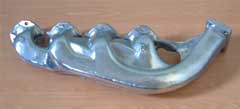
The newer manifold is on the left with the older one on the right. You can see the strengthening between ports 2-3 and 3-4. The newer manifold is silver in colour, this is because it have been coated by CamCoats. This is suppose to protect the manifold from corrosion and contain the heat in the manifold. After talking to Lotus's engineers who worked on the development of the manifolds, it was advised not to get the manifolds coated, as this hadn't been tested and there was a worry the contained heat build up could affect other areas. Also a couple of Esprit owners who have had this coating on their manifolds (around £200) have reported peeling and corrosion of the coating in a very short time.
The later manifold has been tested by Lotus to a maximum of 280bhp and should last around 80,000 miles. Obviously most of this testing has been done on the test bed and doesn't take into account the British weather. Some think that if a hot manifold (they can reach temperatures of 1000°c under boost and you can see them glowing red after a good run) gets cold water sprayed on it in large amounts, say going through a large puddle, this can cause it to crack due to the sudden change it temperature. A few owners have been known to fit splash guards around their manifolds. All of this, of course, is unproven and is just for your information.
Tackling the job yourself!
If you have the skills, tools, space and especially time to tackle the job yourself this guide taken from the UKYahoo! Egroup might be of some use to you. Quite a few owners have done this job themselves, so it is possible and also a lot cheaper. If you try this and want to add anything to this page, please email the usual address.
"The last manifold job went without a hitch with no unplanned side-trips. It took about about 3 hours start to finish.
However, getting the turbo-related nuts-n-bolts off can be time consuming if they're stubborn, and they usually are. If you snap off a bolt or stud, the time to fix that will add significantly. If the broken bit is in the old manifold, that's not a big deal, but there are still enough other fasteners to be a problem. The studs on the turbo that mount the exhaust pipe are prone to snapping as the nuts are removed. Take it easy.
Start by soaking the turbo fasteners with penetrating oil for a day prior to starting. Apply frequently and let them soak. Access to the turbo mounting bolts is poor. I like to remove the boot floor/ bulkhead first. It takes time, but the improved access makes access to the turbo bolts so much easier that it's faster in the long run.
The best method I've found for getting on the turbo bolts is to use a socket with an integral U-joint. A separate socket and U-joint combined is too long to fit in the available space, but the integral unit fits. It's worth the investment. John at WC Engineering swears the Snap-On version is the only way to go because the fit on the hex-head is excellent… minimal chance of rounding off the hex. However, I've had no problem with the fit of the Craftsman version, and the socket portion is not as tall… it fits into the available space better.
Anyway, that and a couple of long extensions will get your hands back where you can get a better grip and apply more force.
Easy on the force. Those bolts have been through heat-hell and are brittle. And they're usually stuck. Bring the torque up on the paranoid scale. If they don't pop loose with reasonable abuse, apply more penetrating oil. When they do pop, don't try to just spin them out all at once. They're rusted in and will fight tooth and nail all the way out. If you just keep cranking on them, sometimes they'll snap halfway out… about when you think you're home free.
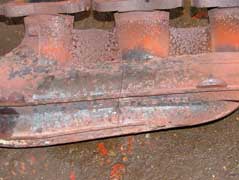

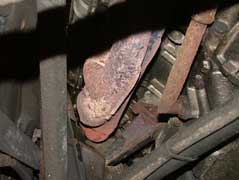
When it pops loose, apply more penetrating oil and work the bolt back and forth. Now the oil has a gap to flow into… help it along. Back the bolt out. If it hits a hard spot, don't force it more than a turn or two. Then screw it back in and out a gain… plus another turn. Then in and out plus another. The manifold itself it just a matter of poor access. It's not technically challenging, it's just a test of flexibility. Small arms & hands combined with multiple wrists and double-jointed fingers helps.
Support the engine and remove the left engine mount strut/ leg. The large vertical bolt in the outer end of the strut is too long to remove… it hits the bottom of the manifold. But you can at least loosen it, unbolt the inner end from the block, then swing the strut out of the way.
A few of the nuts can be reached with a small socket on an extension. A 1⁄4 inch drive works well since the bits are all generally smaller and the extensions are so slender. But most of the nuts will be one flat at a time with an open end wrench. Collect all the short open ends you can get your hands on, all with different angles between the head and handle. Smaller, thinner heads are good as are shorty wrenches. Then it's just patience. One nut I had to use three wrenches, one flat at a time, switching wrenches between flats. Patience.
One of the nuts on the bottom, toward the front is in a notch relief cut into the manifold. 3rd stud? Look for it. The relief isn't cut deep enough for the nut to spin off the end of the stud. It hits the end of the relief long before coming off. So all the rest of the nuts must be backed off far enough to allow the manifold to be pulled back far enough to continue turning that one troublesome nut. It's a three handed job.
Absolutely do not forget about that PIA nut when installing the manifold. It has to be installed before any other nuts are run all the way home. Hold the manifold away from the head so you can install the one nut and then proceed with the others. If you cinch the manifold down with other nuts before installing that one, it will not go on. No way.
If you completely remove the motor mount strut after the manifold comes off, be sure to start the long vertical bolt through the rubber mount before bolting the new manifold in place. That big bolt will not go in after the manifold is in place.
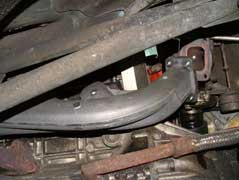
The OEM manifold-to-head gaskets are double laminate stainless steel. A friend used to get triple laminate gaskets out of England for me that were better. I never knew if they were Lotus-UK OEM or aftermarket, but LCU didn't have them. I sent some samples to Jeff at JAE, and he now sells a different version of a 3-lam gasket. I don't know how widely available they are now, but JAE has them and they're worth the trouble to locate.
Use stainless studs if you have to replace any. Use the special small-hex, copperized, distorted-thread lock nuts available from Lotus parts suppliers. It's best to use all new nuts on assembly.
When you re-install the motor mount strut, use medium strength Loctite on the threads (blue, 243 / 243). The bolt holes in the block are drilled and tapped deeper than the OEM bolts reach. I measure the depth and then put in the longest bolts that will fit… grab all the thread you can. Last time I also used Allen drive cap screws on (?) two of the locations. It's easier to get on them with about a 6" long, ball-end, Allen wrench with socket drive (ratchet). The third bolt (bottom front?) is tucked in behind the strut leg enough that there's really no choice other than approaching it from the side with an open end wrench.
It's a nasty job at best, and it can go rapidly down hill from there. Good luck.
Regards,
Tim Engel
Lotus Owners Oftha NorthFitted my new manifold at last on the weekend tip of the day - the nuts that hold the manifold onto the head are 8mm with 13m AF selflocking in stainless i didn't use these buy titainium K nuts from tastybolts these are 8mm but only 10mm AF oh god does this make fitting the new manifold quiker now you can get a 1/4 socket on and a 10mm spanner in the right places cost of bolts £45 saved temper,time,frustration and knuckles priceless did 400 miles and reckecked the nuts all is rosy in the garden
regards
richardHaving a Manifold fitted
December 2001
Esprit SE's New Manifold
After finding out that there was a crack in the Manifold of LEW's Esprit, we started looking for somebody to do the job. Changing an Esprit Manifold is one of the hardest jobs to undertake on an Esprit. There are two ways of tackling the problem, leave the engine in, or take it out. Most Independents where quoting a cheap price leaving the engine in, but saying if the manifold was seized on then the engine would have to come out, almost doubling the labour charges, and with it the bill. Those few that said they would take the engine out, did so because in their experience most of the time they would end up taking it out anyway. They where quoting a Minimum price for labour as well, saying if their were problems with removing the studs then the charge would go up.
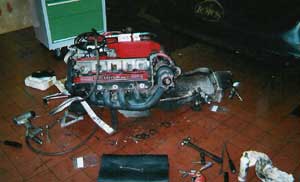
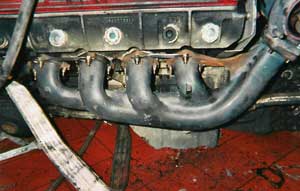
Prices where ranging from £800 to £1800 (2002), with most around the £1200 mark (but no a fixed quote). I chose to take my Esprit back to Lotus and have their service team at Ketteringham do the job (now the sports & performance centre on site at Hethel). They quoted me a maximum price and I felt safer in the knowledge that the team working on my car had been working on Esprit all their careers (although now it seems they only work on Elises). They took the engine straight out to replace the manifold, also replacing the timing belts at the same time as this is easy with the engine out, and as they were changing the engine oil, Antifreeze and Transmission oil, it was cheaper to have my B-Service a couple of months earlier. This put the cost up to around £2,400, which isn't the cheapest, but I feel with Esprit's its not worth getting things done cheaply, especially a job like this.
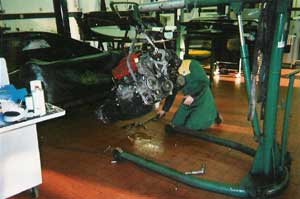
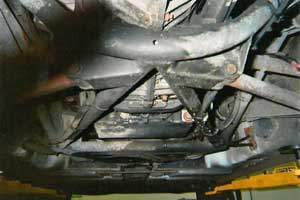
The Esprit was dropped off on a Monday (just so we could have a look around the Factory and the service area, which used to be the headquarters for the F1 team) and picked the car up the following Friday from the Factory Carpark after paying the bill over the phone Friday morning. We were informed of any problems, with cost, before it was done (new header tank needed). We were very satisfied with the service received (although not the cheapest) and would be happy for them to undertake further work in the future. One thing I would consider, is to source parts for any jobs yourself as Lotus part can be priced over the top. We were told we would need four new light in the near future as they were all corroding. Lotus prices were over £600 for the four. Les Twigg can supply the headlines (not Main Beam) for £35 each which we could fit ourself, so we wouldn't advise you to drop your Esprit off and ask them to fix everything, just ask them to report faults and estimate prices first.
Exhaust Manifold Parts
4 x Manifold to head gaskets £68.08 1 x Manifold (older version) £398.21 2 x Lockplate £11.98 4 x Lockplate £23.72 12 x Nut £22.21 12 x Stud £41.42 1 x Manifold to turbo gasket £17.05 4 x Stud £7.81 2 x Lockplate £25.02 4 x Nut £21.16 2 x Driveshaft Pins £2.18
2 x Driveshaft Pins £2.44
Prices exclude VAT @ December 2001
Remember if you choose to take the engine out you'll also need Engine Oil, Transmission Oil and Antifreeze.
Stainless Steel Manifolds
A few people have been asking how the search for a stainless Steel Manifold for the 4-cylinder Esprits was going. After talking to the factory, some Lotus independents and exhaust makers, LEW came to a bit of a dead end. The trouble with the stainless steel version, is that it couldn't support the weight of the turbo once it reaches high working temperatures, around 1000°C. The cast manifold can easily support the weight at this temperature.
After talking to a few suppliers a company said they could make a crane to support the weight of the turbo, that would be attached to the side of the engine block. The price for this would be around £1,000, which isn't a bad price, but the problem is this design was totally untried and untested, which was quite a risk. So it anyone wishes to become a test bed for other Esprit owners, we'd love to see the results. At the moment we are stuck with the 'cracking' cast Lotus version or....
SWLC Iron Manifolds
South West Lotus Centre have had an exact replica of the original Lotus manifolds but made out of a stronger grade of iron, so that they will last longer. SWLC have had no reported failures of their new stronger manifold and with a price cheaper than the Lotus one, It shouldn't be a difficult decision.
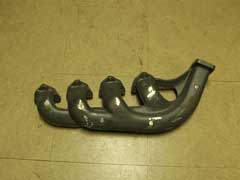

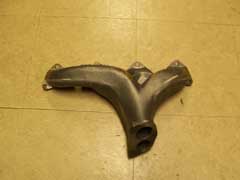
SWLC have been using these manifolds for about 6.5 years. They are made from S.G. Iron which is Spherodine* Graphite. They are 420-12 grade as opposed to Silicone Monobidium* Iron.
They've told LEW that the main difference between the two manifolds is that the S.G. grade will range from -20 °c to 750 °c, and will contract back to its original template, thus avoiding the creation of stress points resulting in cracks.
The manifolds that are available are:
• 907 type Exhaust Manifold (Elite, Eclat, Excel, Esprit N/A up to 1985) – £275.00 + VAT (Retail £348.21)
• Wastegate Adaptor Manifold for Esprit Turbo 1980-85 (now Obsolete) – £450.00 + VAT (Last Retail £562.78)
• Later type Exhaust Manifold for Esprit Turbo 1988-96 – £450.00 + VAT (Retail £639.64)
We were told there was no need for the larger fixing holes and ribs because of the flexibility of the iron.
SWLC have now sold over 450 of the various manifolds with only one being returned, and this one was not due to any of the characteristics of the manifold, rather a quality control mistake whereby a hole had simply not been drilled through correctly by the manufacturer!
Lotus Esprit World Club Members are entitles to an extra 5% off these prices.
Kind regards,Looks like they have finally come up with one from PUK in Germany, not cheap but ceramic coated and ' tested'....
After a very long wait and a long test time we are proud to offer this new ceramic coated tubular manifold for your 4 cylinder Esprit.
- Free flow design
- very light, weighs only around 6 kg
- produced from very high quality stainless steel
- comes with a professionally applied ceramic coat
- it will easily fit all 4-Cylinder Esprits from MY88 onwards (= with integrated turbo wastegate)
- it will replace the old and heavy cast iron manifold in every aspect
|
|